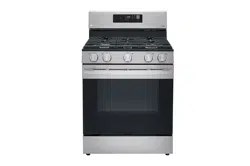Documents: Go to download!
- Owner's manual - (English, Spanish)
- PRODUCT OVERVIEW
- OPERATION
- MAINTENANCE
- TROUBLESHOOTING
Table of contents
OWNER’S MANUAL GAS RANGE
PRODUCT OVERVIEW
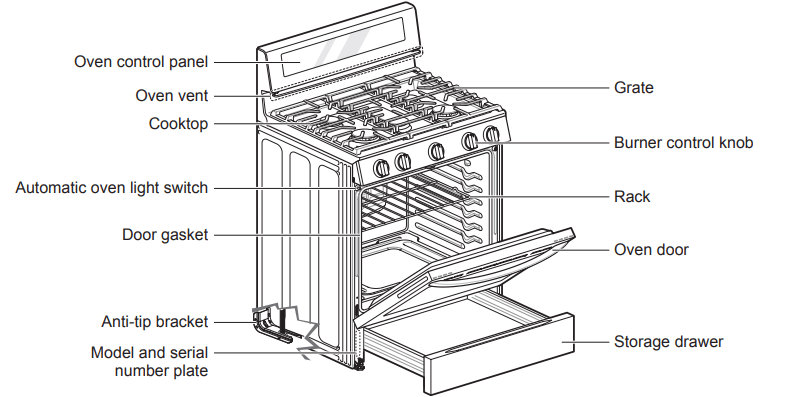
OPERATION
Gas Surface Burners
Burner Locations
Your gas range cooktop has four or five sealed gas burners, depending on the model. These can be assembled and separated. Follow the guide below.
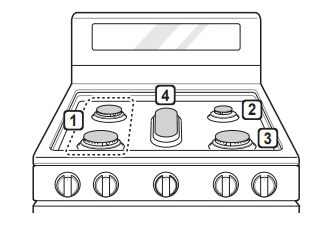
1. Medium and Large Burners - The medium and large burners are the primary burners for most cooking. These general purpose burners can be turned down from Hi to Lo to suit a wide range of cooking needs.
2. Small Burner - The smallest burner is used for delicate foods such as sauces or foods that require low heat for a long cooking time.
3. Extra Large Burner - The extra large burner is the maximum output burner. Like the other four burners, it can be turned down from Hi to Lo for a wide range of cooking applications. This burner is also designed to quickly bring large amounts of liquid to a boil. It can be used with cookware 10 inches or larger in diameter.
4. Oval Burner - The center, oval burner is for use with a griddle or oval pots.
Using the Gas Surface Burners
1. Be sure that all of the surface burners and grates are placed in the correct positions.
2. Place cookware on the grate.
3. Push the control knob and turn to the LITE position.
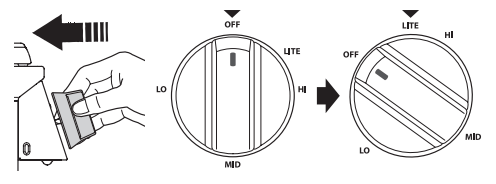
The electric spark ignition system makes a clicking noise. Once the burner is lit, turn the knob counterclockwise to the HI position to stop hearing the clicking noise.
4. Turn the control knob to control the flame size.
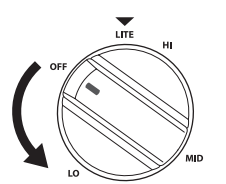
CAUTION: Do not attempt to disassemble or clean around any burner while another burner is on. All the burners spark when any burner is turned to Lite. An electric shock may result causing you to knock over hot cookware.
Setting the Flame Size
Watch the flame, not the knob, as you reduce heat. Match the flame size on a gas burner to the cookware being used for fastest heating.
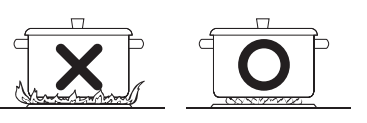
CAUTION: Never let the flames extend up the sides of the cookware.
NOTE
- The flames on the surface burners may burn yellow in the presence of high humidity, such as a rainy day or a nearby humidifier.
- After LP gas conversion, flames can be bigger than normal when you put a pot on the surface burner.
In Case of Power Failure
In case of a power failure, you can light the gas surface burners on the range with a match. Surface burners in use when an electrical power failure occurs will continue to operate normally.
- Hold a lit match to the burner, then push in the control knob.
- Turn the control knob to the Lo position.
CAUTION: Use extreme caution when lighting burners with a match. It can cause burns and other damage.
Range-Top Cookware
| Aluminum | Medium-weight cookware is recommended because it heats quickly and evenly. Most foods brown evenly in an aluminum skillet. Use saucepans with tight fitting lids when cooking with minimum amounts of water. |
| Cast-Iron | If heated slowly, most skillets will give satisfactory results. |
| Stainless Steel | This metal alone has poor heating properties and is usually combined with copper, aluminum or other metals for improved heat distribution. Combination metal skillets work satisfactorily if they are used with medium heat as the manufacturer recommends. |
| Enamelware | Under some conditions, the enamel of this cookware may melt. Follow cookware manufacturer’s recommendations for cooking methods. |
| Glass | There are two types of glass cookware. Those for oven use only and those for top-of-range cooking. |
| Heatproof Glass Ceramic | Can be used for either surface or oven cooking. It conducts heat very slowly and cools very slowly. Check cookware manufacturer’s directions to be sure it can be used on gas ranges. |
Using a Wok
If using a wok, use a 14-inch or smaller flat-bottomed wok. Make sure that the wok bottom sits flat on the grate.
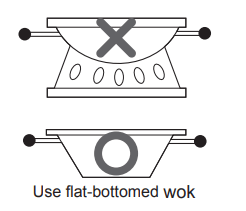
CAUTION: Do not use a wok support ring. Placing the ring over the burner or grate may cause the burner to work improperly, resulting in carbon monoxide levels above allowable standards. This can be hazardous to your health.
Using Stove-Top Grills
Do not place stove-top grills on the burner.

CAUTION: Do not use stove top grills on the surface burners. Using a stove top grill on the surface burner will cause incomplete combustion and can result in exposure to carbon monoxide levels above allowable current standards. This can be a health hazard.
Using the Griddle

The non-stick coated griddle provides an extra-large cooking surface for meats, pancakes or other food usually prepared in a frying pan or skillet.
NOTE: It is normal for the griddle to become discolored over time.
How to Place the Griddle: The griddle can only be used with the center burner. The griddle must be properly placed on the center grate, as shown below.
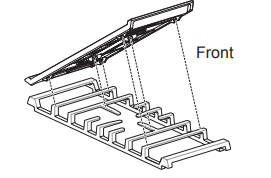
CAUTION
- Do not remove the center grate when using the griddle.
- Do not remove the griddle plate until the cooktop grates, surfaces and griddle plate have completely cooled.
- The griddle plate on the cooktop may become very hot when using the cooktop, oven or broiler systems. Always use oven mitts when placing or removing the griddle plate.
Preheat the griddle according to the guide below and adjust for the desired setting.
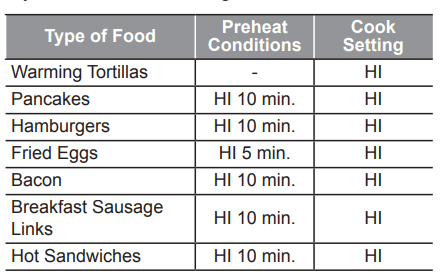
NOTE: After cooking on the griddle for an extended period, adjust the griddle temperature settings as the griddle retains heat.
IMPORTANT NOTES
- Avoid cooking extremely greasy foods as grease spillover can occur.
- The griddle can become hot when surrounding burners are in use.
- Do not overheat the griddle. This can damage the non-stick coating.
- Do not use metal utensils that can damage the griddle surface. Do not use the griddle as a cutting board.
- Do not place or store items on the griddle.
The Oven
Before Use
Read all instructions before using.
Make sure the electrical power cord and the gas valve are properly connected. Confirm the correct use of the range for the type of food you will cook.
Make sure you know how to use the oven (temperature setting, time setting and recipe) for best results.
In case of power failure, do not use the oven. The oven and broiler cannot be used during a power outage. If the oven is in use when a power failure occurs, the oven burner shuts off and cannot be relit until power is restored. Once power is restored, you will need to reset the oven (or Broil function).

Do not block, touch or place items around the oven vent during cooking.
Your oven is vented through ducts at the center above the burner grate. Do not block the oven vent when cooking to allow for proper air flow. Do not touch vent openings or nearby surfaces during any cooking operation.
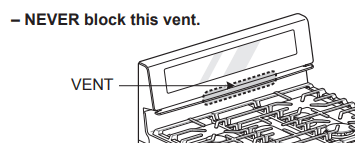
Do not cover the cooktop surface with aluminum foil. Blocking the oven vent can damage the control panel.
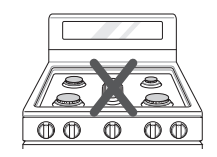
Do not cover racks or oven bottom with aluminum foil.

You may see condensation on the oven door glass.
As the oven heats up, the heated air in the oven may cause condensation to appear on the oven door glass. These water drops are harmless and will evaporate as the oven continues to heat up.

Control Panel Overview

- Features
- Oven Controls
- Number Buttons or +/- Buttons
- Start Button
- Clear Off / Lockout Button
- Smart Diagnosis
Flashing Time
If your oven displays a flashing clock, press Clock or press any key to stop the flashing.
Changing Oven Settings
Clock
The clock must be set to the correct time of day in order for the automatic oven timing functions to work properly
- Press Clock.
- Press the +/– buttons to set the time.
- Press Start.
NOTE
- The time of day cannot be changed during a timed baking.
- If no other keys are pressed within 25 seconds of pressing Clock, the display reverts to the original setting.
- If the display time is blinking, there may have been a power failure. Reset the time.
- When the power is turned on for the first time, the clock screen flashes. Press any key to turn on the product.
Oven Light
The interior oven light automatically turns on/off when the door is opened and closed. Press Light or knock on the door glass twice to manually turn the oven light on/off.
Timer On/Off
The Timer On/Off feature serves as an extra timer in the kitchen that beeps when the set time has run out. It does not start or stop cooking. The Timer On/Off feature can be used during any of the other oven control functions.
- Press Timer On/Off button once to set the time in hours and minutes, or press the button twice to set the time in minutes and seconds. TIMER flashes in the display
- Set the time. Use the +/- buttons.
- Press Timer On/Off to start the Timer. The remaining time countdown appears in the display. NOTE: If Timer On/Off is not pressed, the timer returns to the time of day.
- When the timer reaches 0:00, End shows in the display. The clock beeps every 15 seconds until the Timer On/Off button is pressed. NOTE: If the remaining time is not in the display, recall the remaining time by pressing Timer On/Off.
Cancelling the Timer
- Press Timer On/Off once. The display returns to the time of day.
Settings
Press the Settings button repeatedly to toggle through and change oven settings
Setting the Hour Mode
The control is set to use a 12-hour clock. To reset the clock to 24-hour mode, follow the steps below.
- Press and hold the Settings button.
- Press +/– to toggle between a 12-hour and 24- hour clock.
- Press Start to accept the change
Adjusting the Oven Thermostat
This oven may cook differently from the one it replaced. Use the oven for a few weeks to become more familiar with it before changing the temperature settings. After becoming more familiar with the oven, if you notice a pattern of over- or underheating, follow these steps to adjust the thermostat.
NOTE: To begin, either raise or lower the thermostat 15 °F (8 °C). Try the oven with the new setting. If the oven still needs adjustment, raise or lower the thermostat again, using the first adjustment as a gauge. For example, if the adjustment was too much, raise or lower the thermostat 10 °F (5 °C). If the adjustment was not enough, raise or lower the thermostat 20 °F (12 °C). Proceed in this way until the oven is adjusted to your satisfaction.
- Press Settings repeatedly until AdJU appears in the display
- Set the number of degrees to adjust: Press or press and hold the +/– buttons until the desired number of degrees appears in the display. Press Settings again to add a minus sign if decreasing the temperature.
- Press Start to accept the change.
NOTE
- This adjustment does not affect the broiling. The adjustment is retained in memory after a power failure. The oven thermostat can be increased (+) or decreased (-) as much as 35 °F or 19 °C.
- Once the thermostat is increased or decreased, the display shows
Turning the Preheat Alarm Light On/Off
When the oven reaches its set temperature, the preheating alarm light flashes 5 times or until the oven door is opened. You can activate or deactivate the preheating alarm light.
- Press Settings repeatedly until PrE appears in the display.
- Press +/– to turn the light on/off.
- Press Start to accept the change.
Adjusting the Beeper Volume
- Press Settings repeatedly until Beep appears in the display.
- Press +/– to select Hi, Lo or Off.
- Press Start to accept the change.
Selecting Fahrenheit or Celsius
Set the oven temperature display to show either Fahrenheit (°F) or Celsius (°C) units. The oven defaults to Fahrenheit unless changed by the user.
- Press Settings repeatedly until Unit appears in the display.
- Press +/– to select F (Fahrenheit) or C (Celsius).
- Press Start to accept the change.
Lockout
The Lockout feature automatically locks the oven door and prevents most oven controls from being turned on. It does not disable the timer and the interior oven light.
- Press and hold Clear/Off for three seconds.
- The lock melody sounds, Loc appears in the display(available on some models) and the lock
 blinks in the display.
blinks in the display. - Once the oven door is locked, the lock
 indicator stops blinking and remains on.
indicator stops blinking and remains on. - To deactivate the Lockout feature, press and hold Clear/Off for three seconds. The unlock melody sounds and the door and the controls unlock.
NOTE: In models without a self-clean mode, the Lockout feature locks the controls but not the oven door. The lock  indicator does not blink.
indicator does not blink.
Cook Time (Timed Cook)
Set the oven to cook for a specific length of time using the Timed Cook feature. This feature can only be used with the Bake, Conv. Bake, Conv. Roast, Frozen Meal, Slow Cook and Favorite Cook modes.
Setting the Cook Time Function
For example, to bake at 300 °F for 30 minutes, first set the clock to the correct time of day.
- Press Bake. 350 °F appears in the display.
- Set the temperature. Press +/– button.
- Press Cook Time. Timed flashes in the display. Bake, 0:00 appear in the display.
- Set the baking time: Press +/– button to set the baking time. The baking time can be set for any amount of time between 1 minute and 11 hours and 59 minutes.
- Press START.
The oven will continue to cook for the set amount of time and then turn off automatically. When the cooking time has elapsed:
- End and the time of day show in the display.
- The cook end indicator tone sounds every 60 seconds until Clear/Off is pressed.
Changing the Cook Time during Cooking
For example, to change the cook time from 30 minutes to 1 hour and 30 minutes, do the following.
- Press Cook Time.
- Change the baking time: Press +/– button.
- Press START to accept the change.
Start Time (Delayed Timed Cook)
The automatic timer of the Delayed Timed Cook function turns the oven on and off at the time you select. This feature can be used with the Bake, Conv. Bake, Conv. Roast and Self-Cleaning modes.
Setting a Delayed Timed Cook
For example, to bake at 300 °F for 30 minutes and delay the start of baking until 4:30, first set the clock to the correct time of day
- Press Bake. 350 °F appears in the display.
- Set the temperature: Press or press and hold the +/– buttons until the desired temperature appears in the display.
- Press Cook Time and touch +/– keys to set the baking time: touch 3 and 0.
- Press Start Time.
- Set the start time: Use the +/– buttons to adjust the time displayed to match your desired start time.
- Press Start. A short beep sounds, Timed Delay and the start time appear in the display. The oven begins baking at the set start time.
NOTE
- To cancel the Delayed Timed Cook function, touch Clear/Off at any time.
- To change the cooking time, repeat step 3 and touch Start.
- If the oven clock is set as a 12-hour clock, you can delay the cook time for 12 hours. If the oven clock is set as a 24-hour clock, you can delay the cook time for 24 hours.
The oven will continue to cook for the set amount of time and then turn off automatically. When the cooking time has elapsed:
- End and the time of day show in the display.
- The cook end indicator tone sounds every 60 seconds until Clear/Off is touched.
- When Warm is set, the warming function is activated after the cooking time ends.
Removing and Replacing the Oven Racks
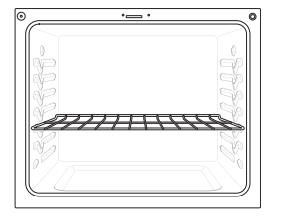
Removing Racks
- While wearing oven mitts, grasp the oven rack*.
- Pull the rack straight out until it stops.
- Lift up the front of the rack.
- Pull out the rack.
* When possible, adjust oven racks before using the oven. Always wear oven mitts if adjusting racks while the oven is on.
Replacing Racks
- While wearing oven mitts, place the end of the rack on the support*
- Tilt the front end of the rack up.
- Push the rack in.
- Check that the rack is properly in place.
*When possible, adjust oven racks before using the oven. Always wear oven mitts if adjusting racks while the oven is on.
Recommended Baking and Roasting Guide
- Center pans on racks for best baking results. If baking with more than one pan, place the pans so that each one has at least 1" to 11/2" of air space around it. Do not allow pans to touch the walls of the oven.
- If cooking on a single rack, place the standard rack in the position suggested in the charts on the following pages. Center the cookware as shown in the single rack baking image.
- If cooking on multiple racks in the oven, place standard racks in positions 2 and 5. For best results, place the cookware as shown. (Place standard racks in positions 3 and 5.

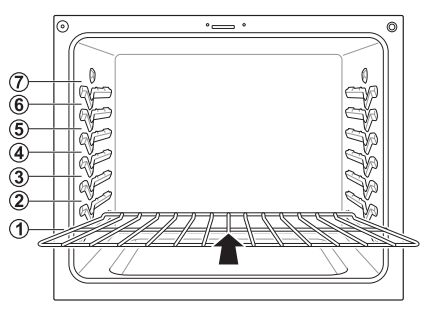
Bake
Bake is used to prepare foods such as pastries, breads and casseroles. The oven can be programmed to bake at any temperature from 170 °F (80 °C) to 550 °F (285 °C). The default temperature is 350 °F (175 °C).
- Press Bake. 350° appears in the display and BAKE flashes.
- Press or press and hold the +/– buttons until the desired temperature appears in the display.
- Press Start to accept the temperature change. As the oven preheats, the temperature is displayed and rises in 5-degree increments. Once the oven reaches the set temperature, a tone sounds and the oven light blinks on and off.
- When cooking is complete, press Clear/Off.
- Remove food from the oven.
Changing the Temperature while Cooking
- Press Bake
- Press or press and hold the +/– buttons until the desired temperature appears in the display.
- Press Start.
NOTE: If the door is opened during baking, the bake burner turns off after 30 seconds. The burner turns back on automatically once the door is closed.
Broil
The oven is designed for closed-door broiling. Broil uses the intense radiant heat from the upper gas burner. The Broil function works best when broiling thin, tender cuts of meat (1" or less), poultry or fish.
When broiling refer to the broiling guide for placing the rack.

Setting the Oven to Broil
- Press Broil once for Hi and twice for Lo.
- Press Start.
- Allow the broiler to preheat for five minutes.
- Place food in the oven.
- Close the oven door. The oven door must be closed during broiling.
- When broiling is finished, press Clear/Off
NOTE: During any Broil function, it is normal for the broiler to cycle on and off. The igniter for the broil burner on the ceiling of the oven glows orange periodically during normal broil operation.
Sabbath Mode
Sabbath mode is typically used on the Jewish Sabbath and Holidays. When the SABBATH mode is activated, the oven does not turn off until the SABBATH mode is deactivated. In SABBATH mode, all function buttons, except for the CLEAR/OFF are inactive. Sb will appear in both the cooktop and oven displays.
NOTE: If the oven light is turned ON and the SABBATH mode is active, the oven light will turn OFF. If the oven light needs to be OFF, be sure to turn the oven light OFF before activating the SABBATH mode. SABBATH mode can only be used in Bake mode.
Setting the Sabbath mode
- Press the Bake button.
- Set the Bake temperature. Use the +/– buttons.
- Press the START button.
- Press and hold the Settings button for three seconds. SB and
 will appear in the display when the Sabbath mode is activated.
will appear in the display when the Sabbath mode is activated. - To cancel the Sabbath mode, press and hold the Settings button for three seconds. To cancel the Bake function, press the CLEAR/OFF button at any time.
Changing the temperature while in Sabbath mode
- Press the Bake button. (No tones will sound and the display will not change.)
- Set the Bake temperature. Use the +/– buttons.
- Press the START button.
NOTE: There is a 15 second delay before the oven will recognize the temperature change.
Remote Start
Remotely starts or stops the preheating function of the appliance. The appliance must be connected to a home Wi-Fi network to use Remote Start.
Setting Remote Start
- Open the oven door and make sure that the oven is empty.
- Press the Remote Start button to enable the function. 3 Start the preheat function on the oven from the LG ThinQ app.
Warm / Keep Warm
This function will maintain an oven temperature of 170 °F. The Warm function will keep cooked food warm for serving up to three hours after cooking has finished. The Warm function may be used without any other cooking operations.
Setting the Warm Function
- Press Warm or Air fry/Warm once
- Press Start.
- Press Clear/Off at any time to cancel.
MAINTENANCE
Gas Surface Burners
Removing and Replacing the Gas Surface Burners
Grates and burner heads/caps can be removed for care and cleaning
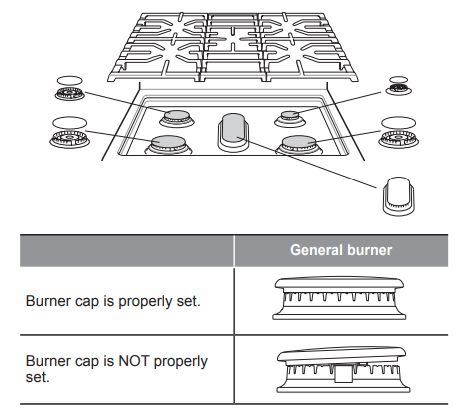
CAUTION: To avoid burns, do not clean the cooktop surface until it has cooled. Do not lift the cooktop surface. Lifting the cooktop surface can lead to damage and improper operation of the range.
Foods with high acid or sugar content may cause a dull spot if allowed to set. Wash and rinse soon after the surface has cooled. For other spills such as oil/ grease spattering, etc., wash with soap and water when the surface has cooled, then rinse and polish with a dry cloth.
Cleaning Burner Heads/Caps
For even and unhampered flame, the slits in the burner heads must be kept clean at all times.The burner heads and caps (and the oval burner head and cap assembly) can be lifted off. Do not attempt to remove the oval burner middle cap.
- Wash the burner caps in hot soapy water and rinse with clean water. Run water through the oval burner from the bottom stem to flush out debris.
- Use care when cleaning the cooktop. The pointed metal ends on the electrodes could cause injury. Hitting an electrode with a hard object may damage it.
- To remove burnt-on food, soak the burner heads in a solution of mild liquid detergent and hot water for 20–30 minutes. For stubborn stains, use a toothbrush or wire brush.
- The burners will not operate properly if the burner ports or electrodes are clogged or dirty.
- Burner caps and heads should be cleaned routinely, especially after excessive spillover.
- Burners will not light if the cap is removed.
After Cleaning the Burner Heads/ Caps
Shake out any excess water and then let them dry thoroughly. Placing the oval burner upside down will allow the water to drain out more easily. Replace the burner heads and caps over the electrodes on the cooktop in the correct locations according to their size. Make sure the hole in the burner head is positioned over the electrode.
Burner Grates
The range consists of three separate professionalstyle grates. For maximum stability, these grates should only be used when in their proper position. The two side grates can be interchanged from left to right and front to back. The center grate can be interchanged from front to back.

NOTE: Do not operate a burner for an extended period of time without cookware on the grate. The finish on the grate may chip without cookware to absorb the heat.
Cleaning the Burner Grates
CAUTION: Do not lift the grates out until they have cooled.
- Grates should be washed regularly and after spillovers.
- Wash the grates in hot, soapy water and rinse with clean water.
- The grates are dishwasher safe.
- After cleaning the grates, let them dry completely and securely position them over the burners.
Cleaning the Cooktop Surface
CAUTION
- To avoid burns, do not clean the cooktop surface until it has cooled.
- Do not lift the cooktop surface. Lifting the cooktop surface can lead to damage and improper operation of the range.
- Carefully remove all items from the top of the range, including grates and knobs.
- Spray the cleared range top surface with a grease remover. (DO NOT use chlorine bleach, ammonia or other cleaners.)
- Use a soft, dry cloth to remove all food and grease residue. DO NOT use abrasive cloths, sponges, or cleaners which may dull or scratch the surface.
- Rinse off the cloth in hot water and continue to wipe the surface until all of the soap residue is removed.
Oven Air Vents
Air openings are located at the rear of the cooktop, at the top and bottom of the oven door, and at the bottom of the range.
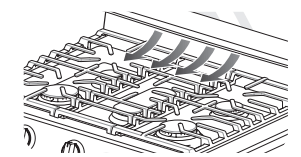
CAUTION:
- The edges of the range vent are sharp. Wear gloves when cleaning the range to avoid injury.
- Clean ventilating hoods frequently. Grease should not be allowed to accumulate on the hood or filter.
NOTE: Do not block the vents and air openings of the range. They provide the air inlet and outlet that are necessary for the range to operate properly with correct combustion.
Control Panel
To prevent activating the control panel during cleaning, unplug the range. Clean up splatters with a damp cloth using a glass cleaner. Remove heavier soil with warm, soapy water. Do not use abrasives of any kind.
CAUTION: Do not use the cooktop at high temperatures for an excessive period as the control panel could be damaged.
NOTE: When spraying on the glass surface, intermittent touch operation is possible.
Front Manifold Panel and Knobs
It is best to clean the manifold panel after each use of the range. For cleaning, use a damp cloth and mild soapy water or a 50/50 solution of vinegar and water. For rinsing, use clean water and polish dry with a soft cloth.
CAUTION
- Do not use abrasive cleansers, strong liquid cleaners, plastic scouring pads or oven cleaners on the manifold panel. Doing so will damage the finish.
- Do not try to bend the knobs by pulling them up or down, and do not hang a towel or other objects on them. This can damage the gas valve shaft.
- The control knobs may be removed for easy cleaning.
- To clean the knobs, make sure that they are in the Off position and pull them straight off the stems.
- To replace the knobs, make sure the knob has the Off position centered at the top, and slide the knob directly onto the stem.
NOTE: To prevent scratching, do not use abrasive cleaners on any of these materials.
Cleaning the Exterior
Painted and Decorative Trim
For general cleaning, use a cloth with hot soapy water. For more difficult soils and built-up grease, apply a liquid detergent directly onto the soil. Leave it on for 30 to 60 minutes. Rinse with a damp cloth and dry. Do not use abrasive cleaners.
Stainless Steel Surfaces
To avoid scratches, do not use steel wool pads.
- Place a small amount of stainless steel appliance cleaner or polish on a damp cloth or paper towel.
- Clean a small area, rubbing with the grain of the stainless steel if applicable.
- Dry and buff with a clean, dry paper towel or soft cloth.
- Repeat as necessary.
Oven Door
- Use soapy water to thoroughly clean the oven door. Rinse well. Do not immerse the door in water.
- You may use a glass cleaner on the outside glass of the oven door. Do not spray water or glass cleaner on the door vents.
- Do not use oven cleaners, cleaning powders, or harsh abrasive cleaning materials on the outside of the oven door.
- Do not clean the oven door gasket. The oven door gasket is made of a woven material that is essential for a good seal. Care should be taken not to rub, damage, or remove this gasket.
CAUTION: Do not use harsh cleaners or harsh abrasive cleaning materials on the outside of the oven door. Doing so can cause damage.
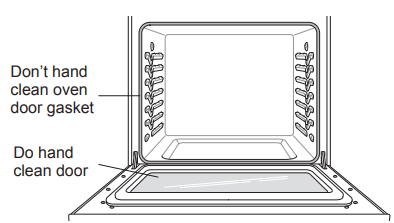
Door Care Instructions
Most oven doors contain glass that can break.
CAUTION
- Do not close the oven door until all the oven racks are fully in place.
- Do not hit the glass with pots, pans, or any other object.
- Scratching, hitting, jarring, or stressing the glass may weaken its structure causing an increased risk of breakage at a later time. Oven Racks
- Food spilled into the tracks could cause the racks to become stuck. Clean racks with a mild, abrasive cleaner.
- Rinse with clean water and dry.
EasyClean®
LG’s EasyClean® enamel technology provides two cleaning options for the inside of the range. The EasyClean® feature takes advantage of LG’s new enamel to help lift soils without harsh chemicals, and it runs using ONLY WATER for just 10 minutes in low temperatures to help loosen LIGHT soils before handcleaning.
While EasyClean® is quick and effective for small and LIGHT soils, the Self Clean feature can be used to remove HEAVY, built up soils. The intensity and high heat of the Self Clean cycle may result in smoke which will require the opening up of windows to provide ventilation. Compared to the more intense Self Clean process, your LG oven gives you the option of cleaning with LESS HEAT,
When to Use EasyClean®

* The Self Clean cycle can be used for soil that has been built up over time.
EasyClean® Instruction Guide
1. Remove oven racks and accessories from the oven.
2. Scrape off and remove any burnt-on debris with a plastic scraper.

Suggested plastic scrapers:
- Hard plastic spatula
- Plastic pan scraper
- Plastic paint scraper
- Old credit card
3. Fill a spray bottle with water (10 oz or 300 ml) and use the spray bottle to thoroughly spray the inside surfaces of the oven.
4. Use at least 1/5 (2 oz or 60 ml) of the water in the bottle to completely saturate the soil on both the walls and in the corners of the oven.
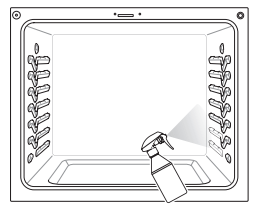
5. Spray or pour the remaining water (8 oz or 250 ml) onto the bottom center of the oven cavity. The indentation on the oven bottom should be fully covered to submerge all soils. Add water if necessary.
NOTE: If cleaning multiple ovens, use an entire bottle of water to clean each oven. Do not spray water directly on the door. Doing so will result in water (10 oz or 300 ml) dripping to the floor.
6. Close the oven door. Press EasyClean®. Press Start.
CAUTION
- Some surfaces may be hot after the EasyClean® cycle. Wear rubber gloves while cleaning to prevent burns.
- During the EasyClean® cycle, the oven becomes hot enough to cause burns. Wait until the cycle is over before wiping the inside surface of the oven. Failure to do so may result in burns.
- Avoid leaning or resting on the oven door glass while cleaning the oven cavity.
7. A tone will sound at the end of the 10 minutes cycle. Press Clear/Off to clear the display and end the tone.
8. After the cleaning cycle and during hand-cleaning, enough water should remain on the oven bottom to completely submerge all soils. Add water if necessary. Place a towel on the floor in front of the oven to capture any water that may spill out during hand-cleaning.
9. Clean the oven cavity immediately after the EasyClean® cycle by scrubbing with a wet, non-scratch scouring sponge or pad. (The scouring side will not scratch the finish.) Some water may spill into the bottom vents while cleaning, but it will be captured in a pan under the oven cavity and will not hurt the burner.

NOTE: Do not use any steel scouring pads, abrasive pads or cleaners as these materials can permanently damage the oven surface.
10. Once the oven cavity is cleaned, wipe any excess water with a clean dry towel. Replace racks and any other accessories.
11. If some light soils remain, repeat the above steps, making sure to thoroughly soak the soiled areas. If stubborn soils remain after multiple EasyClean® cycles.
NOTE
- If you forget to saturate the inside of the oven with water before starting EasyClean®, press Clear/ Off to end the cycle. Wait for the range to cool to room temperature and then spray or pour water into the oven and start another EasyClean® cycle.
- The cavity gasket may be wet when the EasyClean® cycle finishes. This is normal. Do not clean the gasket.
- If mineral deposits remain on the oven bottom after cleaning, use a cloth or sponge soaked in vinegar to remove them.
Cleaning Tips
- Allow the oven to cool to room temperature before using the EasyClean® cycle. If your oven cavity is above 150 °F (65 °C), Hot will appear in the display, and the EasyClean® cycle will not be activated until the oven cavity cools down.
- Using the rough side of a non-scratch scouring pad may help to take off burnt-on stains better than a soft sponge or towel.
- Certain non-scratch scrubbing sponges, such as those made of melamine foam, available at your local store, can also help improve cleaning.
- The range should be level to ensure that the bottom surface of the oven cavity is entirely covered by water at the beginning of the EasyClean® cycle.
- For best results, use distilled or filtered water. Tap water may leave mineral deposits on the oven bottom.
- Soil baked on through several cooking cycles will be more difficult to remove with the EasyClean® cycle.
- Do not open the oven door during the EasyClean® cycle. Water will not get hot enough if the door is opened during the cycle
Setting Self Clean with a Delayed Start
- Remove all racks and accessories from the oven.
- Press the Self Clean button. The oven defaults to the recommended four-hour self clean for a moderately soiled oven. Press Self Clean button to set the time.
- Press Start Time.
- Press the +/– buttons until the display shows the time of day you would like the Self Clean to start.
- Press Start.
NOTE: It may become necessary to cancel or interrupt a Self Clean cycle due to excessive smoke or fire in the oven. To cancel the Self Clean function, press the CLEAR/OFF button.
Changing the Oven Light
The oven light is a standard 40-watt appliance bulb. It turns on when the oven door is open. When the oven door is closed, press Light or knock twice on the oven door glass to turn it on or off.
- Unplug the range or disconnect power.
- Turn the glass bulb cover in the back of the oven counterclockwise to remove.
- Pull the bulb out of the socket.
- Insert a new bulb into the socket.
- Insert the glass bulb cover and turn it clockwise.
- Plug in the range or reconnect the power.
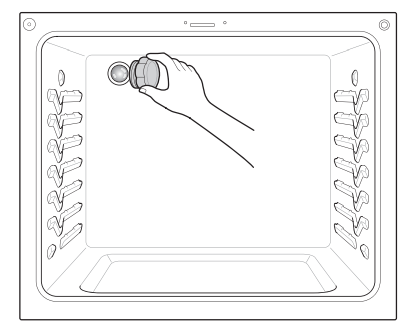
Removing and Replacing the Lift-Off Oven Doors and Drawer
Removing the Door
1. Fully open the door.
2. Unlock the hinge locks, rotating them as far toward the open door frame as they will go.

3. Firmly grasp both sides of the door at the top.
4. Close the door to the removal position (approximately five degrees) which is halfway between the broil stop position and fully closed. If the position is correct, the hinge arms will move freely.
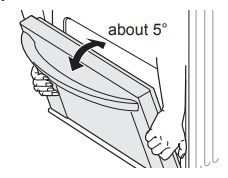
5. Lift door up and out until the hinge arms are clear of the slots.
Replacing the Door
1. Firmly grasp both sides of the door at the top.
2. With the door at the same angle as the removal position, seat the indentation of the hinge arms into the bottom edge of the hinge slots. The notch in the hinge arms must be fully seated into the bottom edge of the slots.
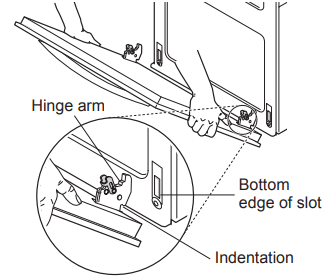
3. Open the door fully. If the door will not open fully, the indentation is not seated correctly in the bottom edge of the slots.
4. Lock the hinge locks, rotating them back toward the slots in the oven frame until they lock.
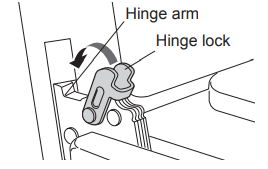
5. Close the oven door.
TROUBLESHOOTING
FAQs
What types of cookware are recommended for use with the cooktop?
- The pans must have a flat bottom and straight sides.
- Only use heavy-gauge pans.
- The pan size must match the amount of food to be prepared and the size of the surface element.
- Use tight fitting lids.
- Only use flat-bottom woks.
My new oven doesn’t cook like my old one. Is there something wrong with the temperature settings?
No, your oven has been factory tested and calibrated. For the first few uses, follow your recipe times and temperatures carefully. If you still think your new oven is too hot or too cold, you can adjust the oven temperature yourself to meet your specific cooking needs. Refer to the Oven Temperature Adjustment section in this manual for easy instructions on how to adjust your thermostat.
Is it normal to hear a clicking noise coming from the back of my oven when I am using it?
Your new range is designed to maintain a tighter control over your oven’s temperature. You may hear your oven’s heating elements click on and off more frequently on your new oven. This is NORMAL.
Why is the time flashing?
This means that the product has just been plugged in, or that it has experienced a power interruption. To clear the flashing time, press any button and reset the clock if needed
Can I use aluminum foil to catch drippings in my oven cavity?
Never use aluminum foil to line the bottom or sides of the oven or the warming drawer. The foil will melt and stick to the bottom surface of the oven and will not be removable. Use a sheet pan placed on a lower oven rack to catch drippings instead. (If foil has already melted onto the bottom of the oven, it will not interfere with the oven’s performance.)
Can I use aluminum foil on the racks?
Do not cover racks with aluminum foil. Covering entire racks with foil restricts air flow, leading to poor cooking results. Use a sheet pan lined with foil under fruit pies or other acidic or sugary foods to prevent spillovers from damaging the oven finish.
CAUTION: Foil may be used to wrap food in the oven or warming drawer, but do not allow the foil to come into contact with the exposed heating/broiling elements in the oven. The foil could melt or ignite, causing smoke, fire, or injury
What should I do if my racks are sticky and have become hard to slide in and out?
Over time, the racks may become hard to slide in and out. Apply a small amount of olive oil to the ends of the racks. This will work as a lubricant for easier gliding.
What should I do for hard to remove stains on my cooktop?
The cooktop should be cleaned after every use to prevent permanent staining. When cooking foods with high sugar content, such as tomato sauce, clean the stain off with a scraper while the cooktop is still warm. Use an oven mitt when scraping to prevent burns. Refer to the MAINTENANCE section of this owner's manual for further instruction.
Why aren't the function buttons working?
Make sure that the range is not in Lockout mode. LOCKED will show in the display if Lockout is activated. To deactivate Lockout, press and hold Clear/Off for three seconds.
My range is still dirty after running the EasyClean® cycle. What else should I do?
The EasyClean® cycle only helps to loosen light soils in your oven range to assist in hand-cleaning of your oven. It does not automatically remove all soils after the cycle. Some scrubbing of your oven range is required after running the EasyClean® cycle.
I tried scrubbing my oven after running EasyClean®, but some soils still remain. What can I do?
The EasyClean® feature works best when the soils are fully soaked and submerged in water before running the cycle and during hand-cleaning. If soils are not sufficiently soaked in water, it can negatively affect the cleaning performance. Repeat the EasyClean® process using sufficient water. Sugar-based and certain greasy soils are especially hard to clean.
Soils on my oven walls are not coming off. How can I get my walls clean?
Soils on the side and rear walls of your oven range may be more difficult to fully soak with water. Try repeating the EasyClean® process with more than the 1/5 of spray bottle recommended.
Will EasyClean® get all of the soils and stains out completely?
It depends on the soil type. Sugar-based and certain grease stains are especially hard to clean. Also, if stains are not sufficiently soaked in water, this can negatively affect cleaning performance.
Do I need to use the full contents of the spray bottle for EasyClean®?
Yes. It is highly recommended that 4/5 of the water be sprayed or poured on the bottom and an additional 1/5 of the water be sprayed on walls and other soiled areas to fully saturate the soils for better cleaning performance.
I see smoke coming out of my oven range’s cooktop vents during EasyClean®. Is this normal?
This is normal. This is not smoke. It is actually water vapor (steam) from the water in the oven cavity. As the oven heats briefly during EasyClean®, the water in the cavity evaporates and escapes through the oven vents.
How often should I use EasyClean®?
EasyClean® can be performed as often as you wish. EasyClean® works best when your oven is LIGHTLY soiled from such things as LIGHT grease splatter and small drops of cheese. Please refer to the EasyClean® section in your owner's manual for more information.
What is required for EasyClean®?
A spray bottle filled with water, a scraper, a nonscratch scrubbing pad and a towel. You should not use abrasive scrubbers such as heavy-duty scouring pads or steel wool.
Is it safe for water to spill into the oven bottom vents during cleang?
Some water spillage into the oven bottom vents (gas range) is okay. However, it is recommended to try avoid spilling too much water into the vents.
Before Calling for Service
Before you call for service, review this list. It may save you time and expense. The list includes common occurrences that are not the result of defective workmanship or materials in this appliance.
| Symptoms | Possible Cause / Solutions | ||||||
| Top burners do not light or do not burn evenly |
|
||||||
| Buttons not working |
|
||||||
| Burner flames are very large or yellow. | If the range is connected to LP gas, contact the technician who installed your range or made the conversion. | ||||||
| Surface burners light but the oven does not. | Make sure that the oven gas shut-off valve, located behind the range, is fully open. | ||||||
| Food does not bake or roast properly. |
|
||||||
| Food does not broil properly in the oven. |
|
||||||
| Oven temperature is too hot or too cold. | The oven thermostat needs adjustment. See Adjusting the Oven Thermostat in the OPERATION section. | ||||||
| Clock and timer does not work. |
|
||||||
| Oven light does not work. |
|
||||||
| Self Clean is not working. |
|
||||||
| “Crackling” or “popping” sound. |
|
||||||
| Too much smoke during the Self Clean cycle. | Too much soil in the oven. Open the windows to get rid of the smoke from the room. Press the CLEAR/OFF button to cancel Self Clean. Wait until the light goes off before trying to open the oven door. Wipe up the excess soil and reset the clean cycle. | ||||||
| The oven door does not open after a Self Clean cycle. | The oven temperature is too high. Wait up to one hour for it to cool down. | ||||||
| The oven door is not clean after a Self Clean cycle. |
|
||||||
| Clean and door flash in the display |
- Close the oven door. |
||||||
| Oven control beeps and displays an F error code. |
|
||||||
| The oven racks were cleaned in a Self Clean cycle. | Apply a small amount of vegetable oil to a paper towel and wipe the edges of the oven racks. Do not use lubricant sprays. | ||||||
| Clock is flashing. | Power outage or surge. Reset the clock. If the oven was in use, you must reset it by pressing the CLEAR/OFF button. Reset the clock and any cooking function. | ||||||
| “Burning” or “oily” odor emitting from the vent. | This is normal in a new oven and will disappear with use. To speed the process, set a Self Clean cycle for a minimum of three hours. See Self Clean in the MAINTENANCE section. | ||||||
| Strong odor. | An odor from the insulation around the inside of the oven is normal for the first few times the oven is used. | ||||||
| Fan noise |
- This is normal. |
||||||
| Fan operation | It is normal for the fan to operate periodically throughout a normal bake cycle in the oven. This is to ensure even baking results. | ||||||
| Burners are not lighting properly after cleaning the cooktop surface. | Make sure that the burner heads and caps are completely dry and properly positioned. | ||||||
| When lighting just one burner, clicking noise is heard from all the burners. | This is normal. Electric spark igniters from the burners cause the clicking noise. All the spark igniters on the cooktop will activate when igniting just one burner. | ||||||
| Light can be seen through the oven air vents. | While the Broil function is running, it is normal to see a light between the oven air vents. |
See other models: LRGL5823D LRGL5823S LREL6321S LREL6323S LREL6323D
